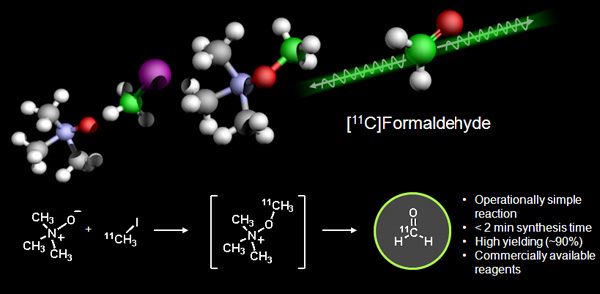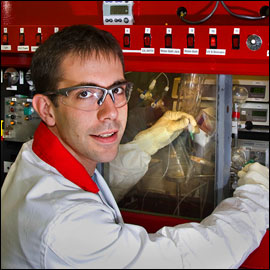New Method Expands Tool Kit for Monitoring Body Chemistry, Disease
July 7, 2008
UPTON, NY — Scientists at the U.S. Department of Energy’s Brookhaven National Laboratory have devised a simple, fast method for adding a radioactive “tag” to formaldehyde, a common organic chemical. Using this labeled formaldehyde, scientists can now synthesize a whole new class of radiotracers, compounds that can be tracked by positron emission tomography (PET) scanners to monitor the movement and interactions of a wide range of chemicals in the human body. A study describing the method was published online on July 4, 2008, by Angewandte Chemie International Edition.
“PET is an extremely valuable tool for understanding human physiology,” said Brookhaven chemist Jacob Hooker, who led the research. PET studies and radiotracers developed at Brookhaven and elsewhere have greatly advanced scientists’ understanding of diseases such as cancer and the neurochemistry of drug addiction.
“But many, if not most, molecules people are interested in studying with PET cannot be radiolabeled right now,” Hooker said. “So there is a huge need for basic science to develop new strategies for making radiotracers. Our new method is part of that effort. It expands our tool kit of reagents and increases the number and types of compounds we can use to peer into the human body.”
Like many existing methods for radiotracer synthesis, the new method incorporates a radioactive form of the element carbon, known as carbon-11 (for the total number of protons and neutrons in its nucleus), into the formaldehyde molecule. Carbon-11 atoms emit positrons — particles similar to electrons but with a positive charge — which can be tracked by a PET scanner. In many carbon-11 radiotracers, the radioactive tag is attached to “exterior” portions of the molecule rather than the carbon chains that make up the backbone of biological molecules. Scientists have long sought ways to label this backbone, as it would greatly expand the kinds of tracers they could make.
Since formaldehyde is involved in many chemical reactions that lead to the synthesis of organic, carbon-chain molecules, it has been a natural target for labeling because it can then be used to make other labeled organic compounds that can be administered to humans as radiotracers.

Trimethylamine N-oxide will react with [11C]methyliodide to form [11C]formaldehyde. This new reaction provides a method to access [11C]formaldehyde without the need for special reagents or conditions. It is anticipated that the widespread availability of [11C]formaldehyde will increase the number of compounds that can be labeled with carbon-11 for use in positron emission tomography (PET), a non-invasive way to image molecular interactions in the human body.
Several groups have devised ways to label formaldehyde using other methods, but they are not routinely used, said Hooker. “While new methods often provide proof of principles, they are often not easily adapted by others to label radiotracers, because they require special equipment and reagents not readily available to all PET chemists,” he said. “Our goal in designing a new route to carbon-11-labeled formaldehyde was to make it simple, efficient, and very easy to repeat.”
Quick reactions
Simple and efficient radiolabeling methodologies are important in carbon-11 chemistry because the radioactive element has a very short half-life — a mere 20.4 minutes. That means the radioactive signal decays, or decreases in strength, by half every 20.4 minutes. So, the entire process has to be fast enough to generate carbon-11, incorporate it into formaldehyde, use that formaldehyde to make a radiotracer, purify, formulate and inject the tracer compound into a research volunteer lying in a PET scanner — all before the radioactive signal decays.
Testing a variety of approaches, the Brookhaven team devised a method using commercially available, inexpensive starting ingredients to produce carbon-11-labeled formaldehyde under mild conditions. The reactions require no special equipment and produce high yields after only a few minutes. “That leaves sufficient time to make useful radiotracers,” Hooker said.
Some tracers Hooker envisions include new compounds to bind with types of brain-cell receptors that were previously “invisible” to PET. The team at Brookhaven is also investigating ways to use carbon-11 formaldehyde to produce radiotracers for monitoring drugs, proteins, and enzymes that affect gene expression in cells.
In addition to Hooker, the research team includes Brookhaven senior chemist Joanna Fowler, and Matthias Schonberger and Hanno Schieferstein, both undergraduates at the University of Mainz, Germany, who participated in an exchange program in nuclear chemistry and research.
The research was funded by the Office of Biological and Environmental Research within the U.S. Department of Energy’s Office of Science, the National Institute of Biomedical Imaging and BioEngineering of the National Institutes of Health, a Goldhaber Fellowship at Brookhaven Lab, and by the German Academic Exchange Service.
Brain-imaging techniques such as PET are a direct outgrowth of DOE’s long-standing investment in basic research in chemistry, physics, and nuclear medicine. The ongoing neuroimaging research at Brookhaven is a prime example of how DOE’s national laboratories bring together the expertise of chemists, physicists, and medical scientists to address questions of profound significance for society.
2008-10805 | INT/EXT | Newsroom










